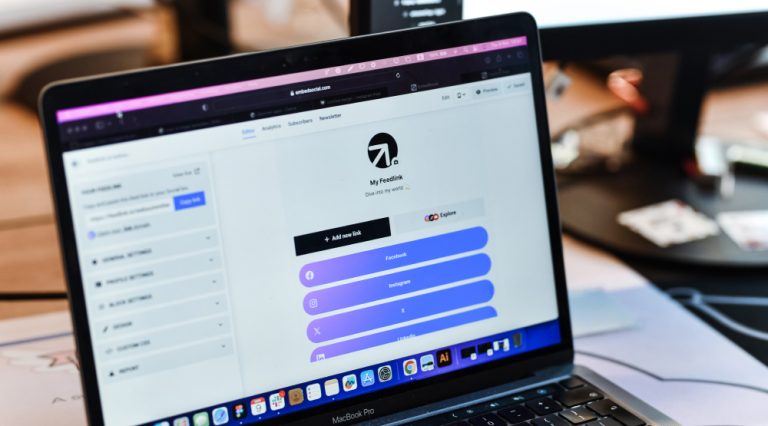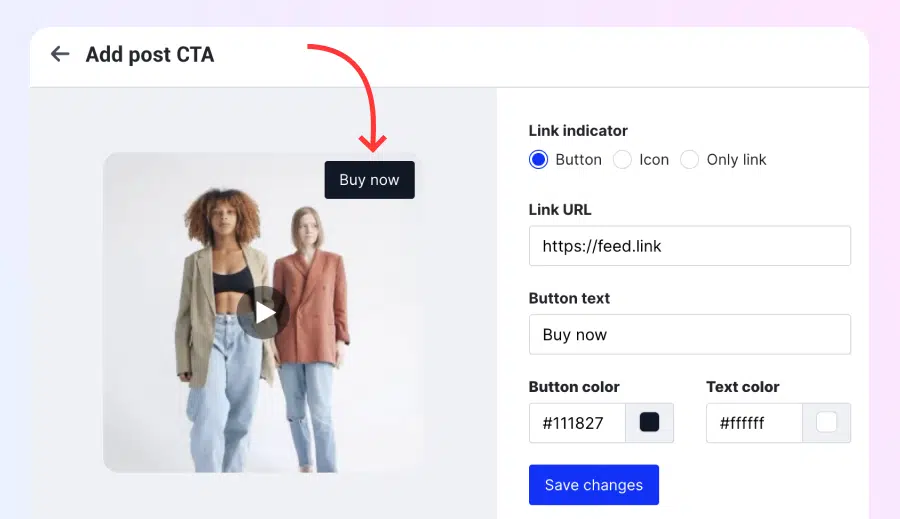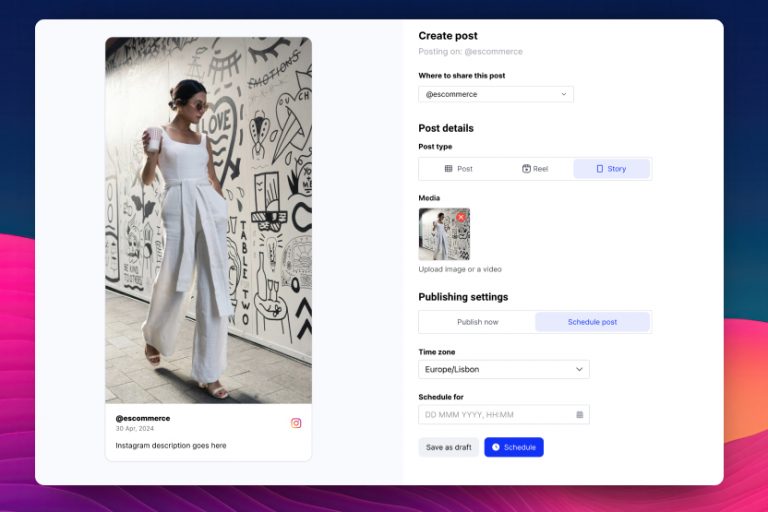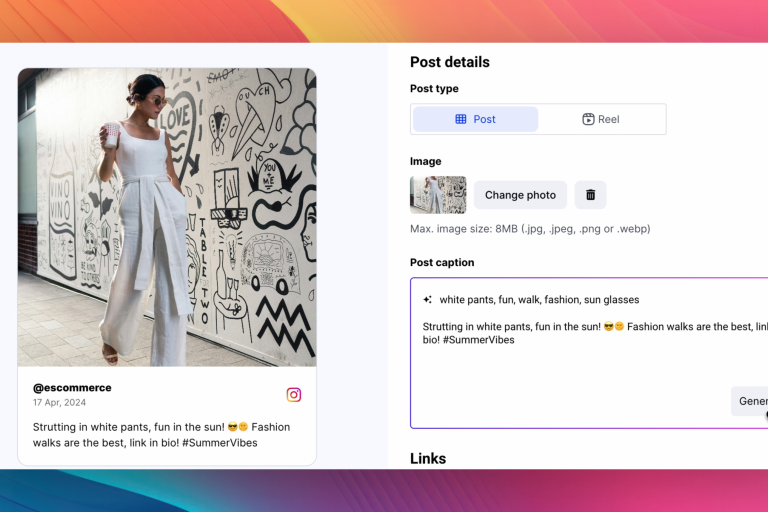Have you just started a small business recently? As it stands, you cannot prosper in today’s modern age without an online presence that starts with a website.
For that reason, we’ll provide you with a detailed guide on how to make a small business website that meets all your personal or professional needs and takes your business to the next level.
Table of contents
- Why create your own website for a small business?
- Why every business needs a website not just social media profiles?
- What does it take to create a small business website?
- Simplifying the website creation process with a website builder
- Alternatives to Feedlink: Top 3 choices for business websites
- What to consider when choosing a website builder?
- Conclusion
- FAQ
Why create your own website for a small business?
Websites are no longer a business luxury but rather a necessity. When making their purchasing decisions, modern consumers always go online!
They trust more businesses that own professional websites, provide details about their product and services, and showcase transparency by displaying positive reviews and testimonials as reassurance.
Here are the key benefits your small business website can unlock:
Build credibility & trust
There’s no better way to showcase your brand identity, expertise, and services than via a virtual storefront in the form of a website. It instantly boosts your credibility in the eyes of potential customers, creating a sense of trust and professionalism that word-of-mouth alone cannot always achieve.
Expand your reach & attract customers
Your website transcends geographical limitations as it acts as a 24/7 billboard for your business, accessible from all over the world. In that effect, search engines and social media platforms become gateways to your website, bringing in customers who wouldn’t have discovered your business otherwise, which opens doors to a much wider audience.
Showcase your products & services
Forget relying on physical flyers or limited store displays. Your website is your virtual portfolio, allowing you to showcase your products and services in detail with captivating visuals and informative descriptions. What that does is provide potential customers with a comprehensive understanding of your offerings, increasing their engagement and conversion rates.
Build stronger relationships with customers
Your website isn’t just a one-way communication channel but rather a platform for fostering genuine connections with your customers. You can build an email list, offer exclusive deals and promotions, and create a blog section to share valuable insights and engage your audience – an interactive approach that fosters loyalty and converts customers into brand advocates.
Gain valuable insights & analytics
Last but not least, your website helps you learn a lot about your buyers and visitors since it offers a treasure trove of data. You can track website traffic, user behavior, and conversion rates—invaluable information that equips you with the insights needed to refine your marketing strategies, optimize your website for better performance, and make data-driven decisions.
Why every business needs a website not just social media profiles?
While social media profiles are crucial for reach and engagement, a website provides a professional, stable, and customizable platform that you fully control. It’s an essential tool for establishing credibility, long-term SEO benefits, and a permanent online presence.
Websites and social media profiles complement each other, and together, they can form a robust online strategy for businesses and individuals alike.
Here are the main reasons why you need a website v.s social media profile:
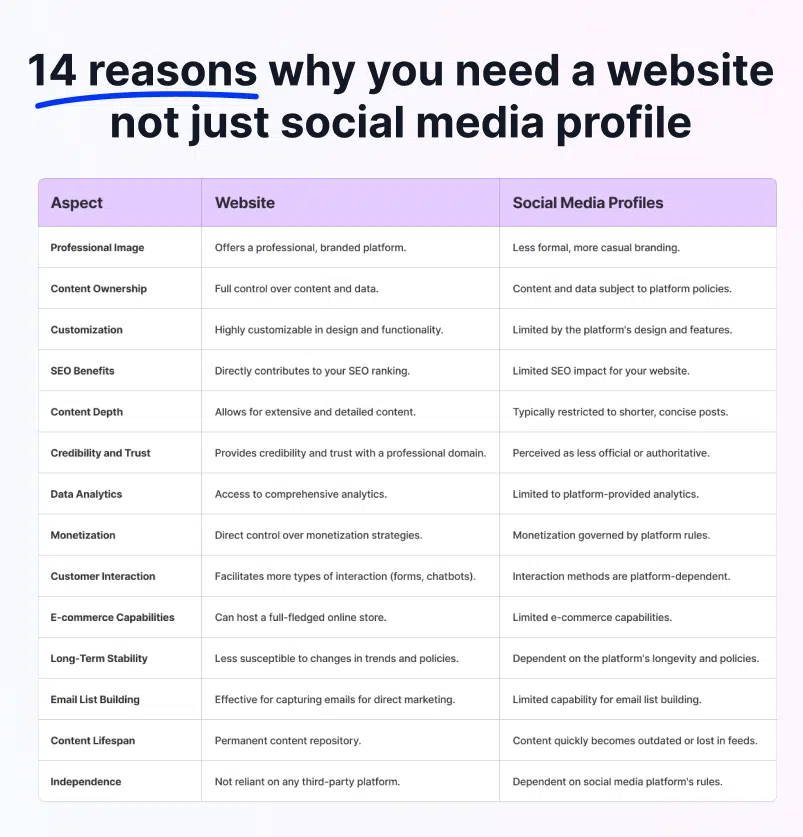
What does it take to create a small business website?
While website building is not typically a lengthy and complicated process, especially when using a website builder, it can still get complicated if you don’t know what you are doing. Therefore, we go over the main steps to create a gorgeous small business website.
1. Pick a short, relevant, and unique name
Before doing anything, you must pick a domain name for your website, which is a very important step since the right name will make the right first impression and entice potential visitors to check out your site’s offerings. For that reason, consider all of the following:
- Keep it short & sweet—you are advised to choose a short and memorable domain name; aim for 15 characters or less, avoiding hyphens and numbers;
- Connect it to your brand—pick a name that reflects your brand and offerings. Use keywords relevant to your industry or niche to attract organic traffic;
- Use a unique name—check for existing trademarks and domain availability; run a quick search to ensure nobody else is claiming your online identity;
- Pick a traditional TLD—opt for traditional top-level domains like .com or .net for broader appeal, or explore industry-specific domains like .shop or .io.;
- Align it to your brand—adjust your domain name with your existing branding in mind for a consistent and impactful experience;
Think of your domain name as your digital anchor, so you must invest time in finding one that’s perfect for you. If you are stuck, you can always jump-start your creativity via a free domain name generator like DomainWheel, which incorporates AI to help you find the best name.
Or use GPT-4 free domain name generator.
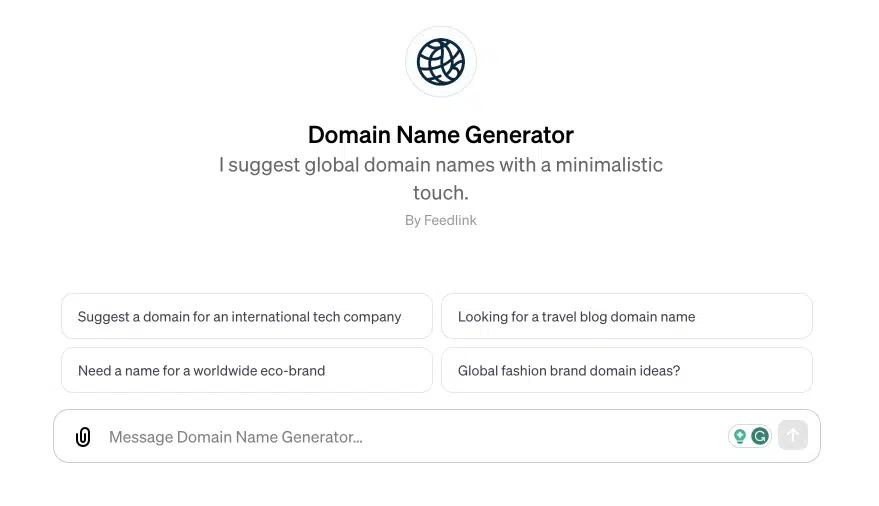
The best thing about DomainWheel is that it only generates names that are available for registration and points you to the right domain registrars to complete the process.
2. Register the name and choose the web hosting & design platforms
Once you choose a domain name, you’ll need to choose a domain registrar, where you’ll have to complete the registration procedure.
For instance, if you choose to register a domain name with Bluehost, which is also a web hosting provider, you have to provide your contact information, add the relevant privacy protection on your domain, and complete your purchase.
The price will depend on factors such as your chosen registrar and the TLD you choose to use, ranging from $5 to $50 per year. However, if you register with a web host provider like Bluehost, you’ll get a free name for a year.
But, small business owners usually don’t have the type or technical knowledge to set up domain names and hosting. Using a domain builder that allows you to purchase and set up the domain name is more practical. For example, Feedlink provides a free .link domain for 1 year, included in the website builder, without the need to learn how to point to DNS or other technical setup of SSL certificate or hosting.
Free domain for 1 year
Claim your .link domain now
That takes us to our next step: choosing your design and hosting providers!
If you are a beginner, you should look into all-in-one options that come with both website design capabilities and a hosting feature for your domain, such as Feedlink, Squarespace, or Wix—all of which include all the perks you need, from a free domain name to SSL security.
When looking for the right service, consider several factors beyond the price, such as its uptime, the bandwidth it offers, and whether or not it includes security features.
As for the design capabilities, you should really go for user-friendly options offering pre-designed templates, especially if you are new to building websites—all of the above options offer such features.
Finally, consider a platform that integrates seamlessly with your other tools, like email marketing software or social media platforms, to streamline your workflow.
3. Produce and add your website’s content
Now that you’ve completed the technical and design setup of your website, it’s time to add all the engaging content you need to entice and captivate new customers.
All successful websites include the following pages and visual elements:
- A captivating homepage – craft a compelling homepage with clear visuals, concise copy, and a strong call to action that instantly grabs attention and introduces your brand;
- Essential information pages—you need informative “About Us” and “Contact Us” pages showcasing your team, values, and contact information. On top of that, include a clear and accessible “Services” page outlining your offerings and benefits;
- A diverse content—diversify your content! Blog posts, case studies, testimonials, and even video content can attract and engage visitors. You need an outlet to share your expertise, showcase your work, and tell your brand story via engaging content;
- Visuals are crucial—images and videos can break up text and add visual interest. Use high-quality visuals that reflect your brand and resonate with your target audience;
- Mobile matters—ensure your website is mobile-friendly, offering a seamless experience across devices. Responsive design is crucial in today’s mobile-first world.
Additionally, you should be able to make a distinction between static and dynamic website content. While static pages, such as the ‘About Us’, ‘Services’, and ‘Contact Us,’ remain unchanged throughout the website, your dynamic pages will change depending on user preference and real-time data—examples include your blog and comment sections.
Check out the following list of blocks to create dynamic pages, i.e.,
- Instagram and TikTok feed
- LinkedIn posts
- Latest blog posts block;
- Contact information block;
- Video block;
- Event block;
- And more.
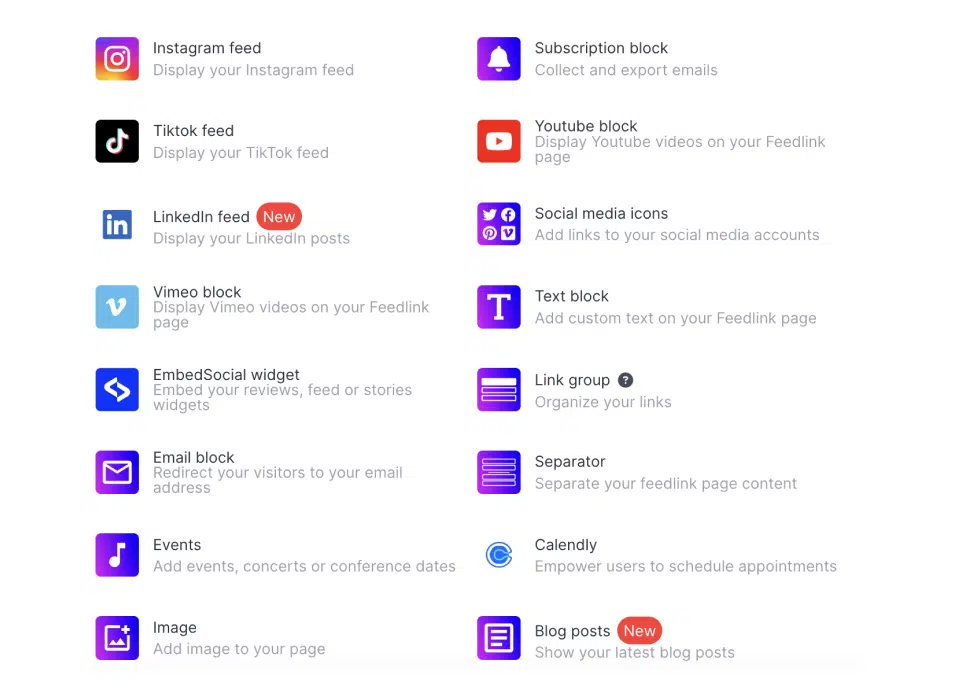
Ultimately, the pages you include must be customized according to your target audience. Also, you must regularly update them, ensuring they are informative, visually attractive, and optimized for search engines. Additionally, when incorporating dynamic content, it’s important to consider the type of content and how it affects the website’s performance.
Remember, your website is a conversation starter. Use powerful and informative content to connect with your audience, establish trust, and convert potential visitors.
4. Implement search engine optimization practices
Nowadays, only websites that search engines can discover have a chance to succeed. For that reason, you have to adopt and implement various search engine optimization (SEO) practices that will put your domain on the map, thus making it discoverable by customers.
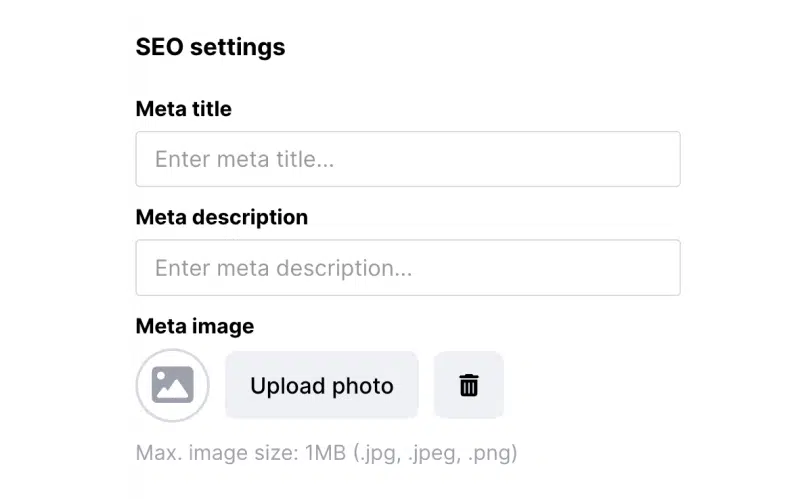
The main SEO strategies that help you achieve that goal include:
- Identify the relevant keywords—you must adapt your content to what people are searching for when looking for a business like yours. Think of them as treasure markers leading curious customers to your online realm. You must integrate them naturally throughout your website, including the titles, meta descriptions, and copies on pages;
- Get as many backlinks as you can—these are the bridges connecting your website to other online domains. So, the more you have, the easier it is for visitors to discover your business website. There are various ways to encourage other similar sites to collaborate with you, thus boosting your authority and SEO visibility, such as guest blogging and exchanging resources;
- Optimize your off-page SEO—while meta titles and keywords are visible SEO elements, there are things you can do in the background to boost your online profile further. For instance, you should optimize your website’s loading speed, image size, and internal linking structure. Once you do, you’ll create a seamless and positive user experience;
- Get a Google My Business listing – if you have a physical presence and/or you operate in a specific region, you must also optimize your website for local searches. You can do that by claiming your Google Business Profile that will showcase your reviews, using local keywords, and highlighting your service area to attract nearby customers;
- Rely on SEO tools—the best way to organize your SEO strategy is via tools like Google Search Console, SEMrush, and Ahrefs, all of which are designed to help you gain insights about your business niche and optimize your content for search engines.
Website managers have access to all sorts of information, including their domain rating, number of backlinks and referral domains, how many keywords the website is covering, and their monthly traffic.
While you must stay on top of your SEO game at all times since user behavior changes and Google updates its search algorithms, the rewards are plentiful.
By constantly refining your own business website map, managing your internal and external links, and maintaining connections to other sites, you can transform your website into a social hub that attracts visitors and ranks highly in Google’s search engine rankings.
5. Review and update the site on an ongoing basis
As already mentioned, your site needs regular attention and updates to remain a powerful online presence for your brand. These are some of the strategies to follow:
- Schedule regular checkups – conducting monthly audits on your website is a necessity. That way, you’ll find and replace broken links and outdated information and fix a variety of performance issues; remember, your website experience must be smooth at all times;
- Stay on top of SEO changes – search engine algorithms shift like desert sands, so stay informed about the latest trends and best practices. That way, you can adjust your keyword strategies, build new backlinks, and keep your website visible;
- Analyze your website data – tools like Google Search Console and website traffic trackers are a staple in your toolbox since they offer valuable insights into user behavior. This data will help you understand what works and what needs improvement;
- Explore new technologies – always explore new features and functionalities, integrate innovative tools, and ensure your website offers a modern and user-friendly experience. Advanced technology helps you reach new horizons and attract more visitors;
- Partner with professionals – get professional designers, developers, and content creators on board to help you keep your business website fresh and engaging. They can help you refine your visual appeal, enhance functionality, and tell your story in innovative ways.
- Keep the content fresh – regularly add new blog posts, product offerings, and promotional material to keep your website interesting, relevant, and authoritative, all for purposes of keeping visitors engaged and coming back for more;
Free blogging tool
Start a blog
Stay vigilant, adaptable, and data-driven. That’s the only way to ensure your website remains an influential domain in your specific business area. Plus, there’s no better way of driving more sales than having a website that does all the heavy lifting for you.
Simplifying the website creation process with a website builder
What is a website builder?
Imagine creating a website without technical knowledge or writing a single line of code. That’s what website builders do. They help you establish your online presence via:
- Ready-made template – pre-designed layouts tailored to your industry and brand, giving you an instant website;
- Effortless customization – options to drag and drop elements like text, images, and contact forms to personalize your business website template and tell your unique story;
- Click-and-launch simplicity – publish your website in a few clicks, making your brand visible to the world and ready to attract customers.
All in all, website builders are like the LEGOs of the website world. They offer intuitive building blocks that let you focus on what truly matters: your business and its message.
Related article.
Feedlink website creation: Step-by-step process
If you don’t want to go through all the hassle of registering a domain name with one service, finding another hosting provider, and yet a third website design service, you should check out Feedlink – a fantastic all-in-one minimalistic builder for a small business website.
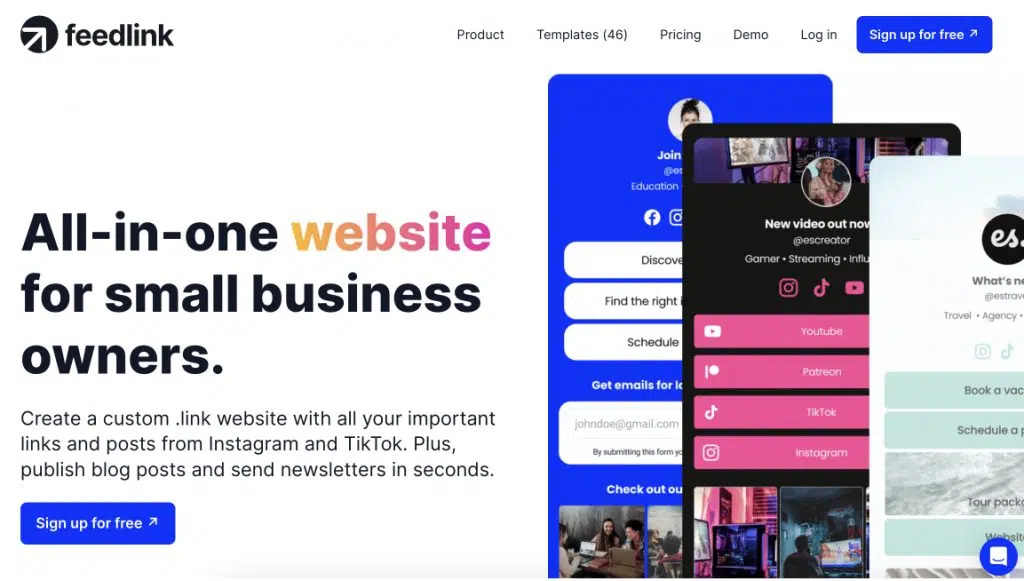
Let us show you just how easy it is to design your free Feedlink page – it includes a few straightforward steps, and you’ll have your page live before you know it.
Step 1: Create your free page
- Sign up for Feedlink.
- First, start with a template with a click ‘Use this template’ or continue without a template.
- Type your website URL or page name and click ‘Next.’
- Edit your new page. In this step, you can explore the Feedlink customization options and adjust the page design and content based on your needs.
Once you finish the above steps, it’s time to connect your social media accounts and get your unique .link domain, which is free for the first year and $12/year afterward.
Step 2: Claim your .link domain
Registering a domain name has never been easier. Domains are available in the PRO plans, and you literally need to click two buttons.
To connect the page with a custom .link domain, follow these steps:
- Go to Domains and click ‘Buy domain’
- Type in your domain name, click ‘Find,’ then ‘Continue with this domain’;
- Fill out your payment information and tap ‘Continue’ to finalize the process;
That’s it. You’ll now receive a confirmation email for your new domain to go live. At this point, you can keep on customizing your page or connect your social media accounts:
Step 3: Display Instagram and TikTok clickable posts
Feedlink allows users to display their latest TikTok or Instagram posts and add clickable links to transform the social media content into a shoppable experience.
This use case is perfect for creating a link in bio page. Here are the steps:
- In the editor, click Explore blocks and select Instagram Feed.
- Connect your Facebook account that manages your Instagram accounts, and choose the account you want to display.
- To add links, click on the image, and in the popup, add the link and label of the buttons. Repeat this with each image you want to tag with an external link.
- Scroll down to the corresponding block, choose your account, then ‘Apply’.
That’s it, and that’s all you need to know! Your website is live, your unique domain, and all your social media accounts are connected. Great first step!
Feedlink features: Empowering your online presence.
If you launch your online journey with Feedlink, you’ll get everything you need to build your perfect minimalistic website, including but not limited to the following:
- Custom .link domain – the best way to stand out from the competition is by having a branded and unique .link domain that will help everyone find your business;
- Easy-to-use blogging feature – Feedlink’s blog feature has been designed for both short and long-form content, and they are extremely straightforward to publish;
- Embedding social media – effortlessly showcase all your social media content on your Feedlink page; best of all, posts are synced automatically once they go live;
- Social media post scheduling – do you want to publish certain social media posts at peak engagement times? Feedlink has a scheduling tool for that purpose!
- Social media newsletter – want to step up your email strategy? Feedlink creates gorgeous newsletters from your social media and automatically distributes them;
- Website analytics – no website is complete without advanced analytics that track your page performance over time to tell you whether your strategy is working;
- Modular design language – Feedlink abides by a modular design language that allows you to add all kinds of new tiles to your page design, ranging from live Instagram and TikTok feeds to subscription and blog posts, and even RSS feeds and a contact card!
All of these features were built from the ground up for small business owners to build a strong online presence for their brands and see their businesses expand fast.
Feedlink templates: Access design diversity
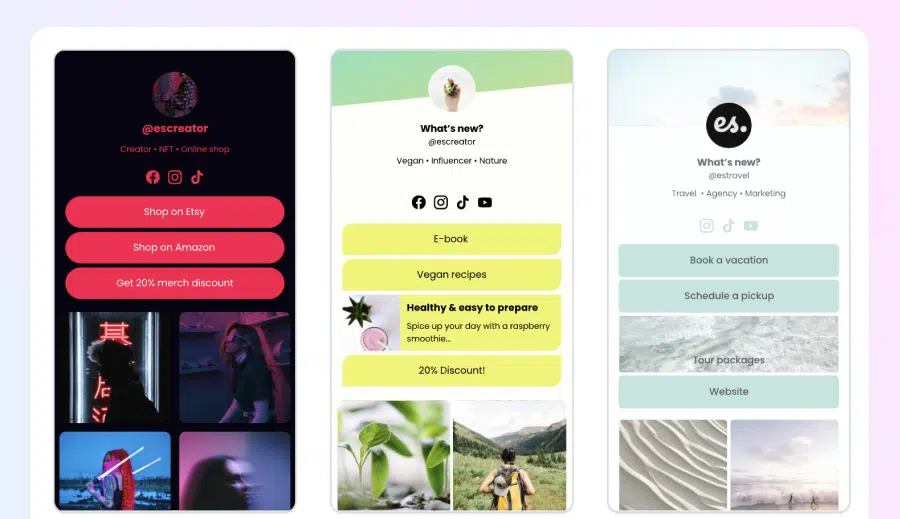
With Feedlink, you get almost 50 fully customizable templates separated into categories for different businesses. You will definitely find one to fit your business needs, and even if it’s not a 100% fit for what you are looking for, you can always tweak it to make it uniquely yours.
You can change the header design and the design of each block you add to your micro-site. Plus, there’s a CSS editor that gives you complete control over your Feedlink portal. View our demo site to see its simple, clean design language in action.
Feedlink pricing plans: Flexible options for every need
Feedlink is one of EmbedSocial’s most affordable yet most complete products. Depending on your needs, you can choose the free plan or one of its three premium subscriptions:
- Feedlink PRO (for professionals)—$6 per month
- Feedlink Business (for businesses)—$19 per month
- Feedlink Agency (for large agencies)—$29 per month
Note: The PRO plan can also be paid annually for $59, saving you $13.
Once you get into the paid plans, you will get access to a social media newsletter feature and a smart link redirect. If you pay for the top-tier plans, you’ll also eliminate EmbedSocial’s branding and access UTM parameters that give you insights into your audience. Also, while the .link domain is free for the first year, you will have to renew it for 12$ every year after that.
Alternatives to Feedlink: Top 3 choices for business websites
If you believe Feedlink is not for you, there are several great alternatives out there. Let’s check out three of the best ones: Wix, Squarespace, and WordPress.com.
1. Wix
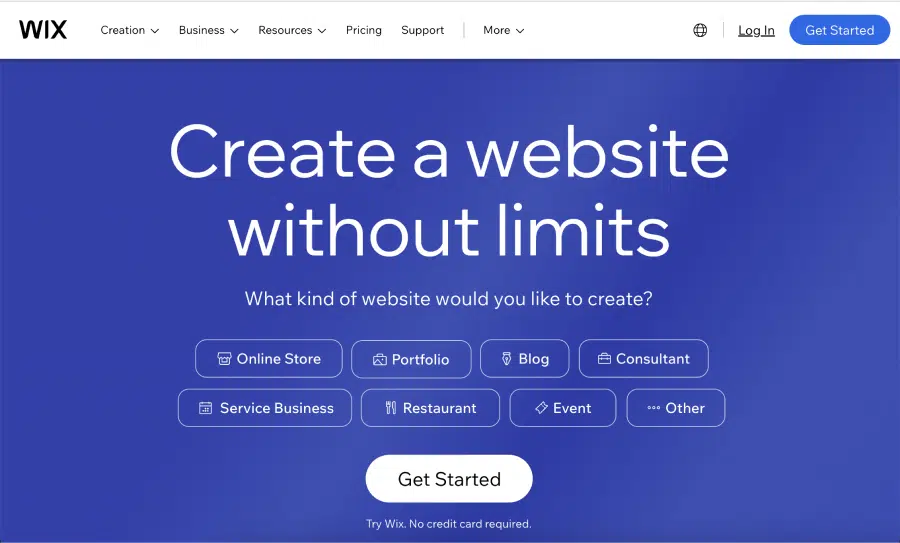
Wix shines as a beginner-friendly builder for a small business website. Its drag-and-drop editor and over 900 customizable templates make it easy to launch a website, build an online store, and sell across multiple channels. Plus, it’s super easy to learn and navigate.
However, while intuitive and secure, Wix might not be the cheapest option for tight budgets, and its e-commerce tools, though strong, might not scale for large stores.
Overall, Wix strikes a great balance between ease, functionality, and customization, making it ideal for entrepreneurs and small businesses seeking a smooth and scalable online presence.
Pricing
In addition to the limited free plan, Wix comes with four premium plans that you can check out with the platform’s 14-day free trial:
- Connect Domain (with branding)—$4.50/month
- Combo (for personal use)—$8.50/month
- Unlimited (entrepreneurs & freelancers)—$12.50/month
- VIP (first-priority support)—$24.50/month
You can find the free one-year domain, unlimited bandwidth, and the platform’s additional functionality only in its top plans. Conversely, if you are launching an e-commerce shop, you have to subscribe to one of Wix’s e-commerce plans.
Pros
- Great customer service and uptime
- Use HTML/SS to build your own theme
- Plenty of website templates and design features
- Various apps in the Wix app market
- Excellent drag-and-drop functionality
Cons
- Cheaper plans don’t have any SEO tools
- The free plan domain is branded
2. Squarespace

Squarespace, known for its stunning design and over 100 customizable templates, caters to small businesses, especially those operating in the creative fields.
Building a visually impactful website and optimizing it for visibility is a breeze thanks to its drag-and-drop tools and built-in SEO features. However, while its e-commerce functionality is useful for small stores, larger e-shops will need much more.
User-friendliness takes a backseat to aesthetics initially, demanding a bit more learning than competitors like Wix and Feedlink. However, competitive pricing and responsive customer support make Squarespace a top choice for businesses prioritizing a beautiful online presence.
Pricing
While Squarespace does not offer a free plan, its four premium tiers still come with a 14-day free trial, after which you can choose one of the following options:
- Personal—$16/month
- Business—$23/month
- Commerce Basic—$27/month
- Commerce Advanced—$49/month
As is the case with other website builders, the more expensive plans hide the best features. Therefore, if you need website analytics and various e-commerce tools, you have to subscribe to one of the commerce plans. Whatever your choice, you have the option to reduce your yearly fees up to 30% if you pay the full subscription price on a 12-month basis.
Pros
- A wide range of contemporary and fashionable templates
- Ready-made designs for specific sections of the site
- Capability to receive donations
- Built-in logo creation tool
- Complimentary domain for the first year
Cons
- No telephone support for customer service
- Lack of a permanently free plan
3. WordPress.com
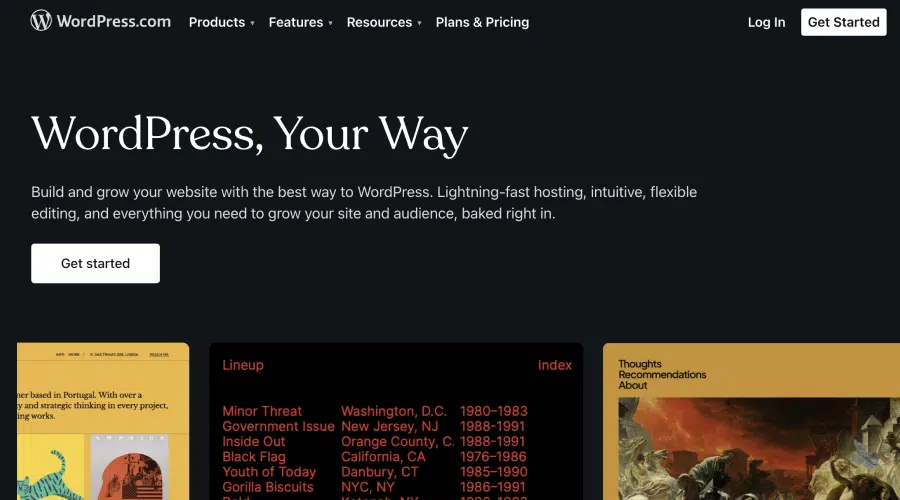
WordPress.com empowers websites and blogs with extensive features and customizable themes. With it, you can build anything from forums to e-commerce sites and more. Best of all, no coding is required, and you get hosting and support at your fingertips.
But be warned, flexibility comes with a learning curve, and beginners might find Wix or Squarespace easier to navigate. That said, for ambitious bloggers and online sellers seeking powerful control and endless customization, WordPress shines.
Think HTML mastery and plugin power-ups – if you’re tech-savvy, WordPress can do it all.
Pricing
While the free plan can get you started, WordPress.com has five distinct payment schemes for various businesses and a 14-day free trial:
- Personal—$4/month or $48/year
- Premium—$8/month or $96/year
- Business—$25/month or $300/year
- Commerce—$45/month or $540/year
- Enterprise—$25,000/year
As you upgrade to higher-tier plans, you gain access to a growing array of sophisticated features to enhance your business and online visibility. For example, all the paid plans offer an ad-free experience, rapid DNS with SSL, and superior support options. The two priciest plans also provide unlimited bandwidth and more complex hosting capabilities.
Pros
- Affordable domain prices begin at $12 annually
- One year of complimentary domain usage with any paid plan
- Superior blogging features
- A vast selection of plugins
- Extensive support for various web hosts
Cons
- Regular updates may be required for themes and plugins
- Subpar page loading speed in the free version
What to consider when choosing a website builder?
When it comes to choosing the right website builder, you need to consider several factors that will help you whittle down all the options out there. So take stock of your own business needs and requirements, then read through the following list to know what to look out for:
- Ease of use – look for a user-friendly website builder, especially if you don’t have much technical expertise or experience in this area. The ones to look out for will have an intuitive interface, drag-and-drop functionality, and clear instructions;
- Customization options – consider how much flexibility you have in terms of design and customization. Ensure the builder offers a wide range of templates and allows you to tweak elements like colors, fonts, and layouts to match your brand identity;
- Responsiveness – with the increasing use of mobile devices, it’s crucial that your website is mobile-responsive. Check if the website builder automatically creates mobile-friendly versions of your business website. If it does not, disregard it as an option!
- SEO features – for your website to be found online, it should be optimized for other search engines. Look for builders that offer SEO tools to help you optimize your business website, including meta tags, alt text for images, and creating SEO-friendly URLs;
- Loading speed – a website that loads quickly is crucial for user experience and SEO. Some website builders are better optimized for speed than others;
- Scalability – think about the long-term. As your business grows, your website will need to grow, too. Choose a builder that allows you to upgrade your business website easily;
- Integration options – check if the website builder can integrate with other tools and services, such as social media platforms, email marketing software, and analytics tools;
- Security features – ensure the website builder has strong security measures in place, like SSL encryption, which are needed to protect your site and visitors’ data;
- E-commerce capabilities – if you plan to sell products or services online, ensure the builder includes e-commerce features like shopping carts, payment gateways, and inventory management. Shopify is built for this exact purpose, for instance;
- Exporting options – consider whether you can easily export your business website to another platform in the future if needed. Some website builders offer this flexibility;
- Pricing – compare the pricing plans of different builders. Consider what is included in each plan, and be aware of any additional costs such as domain or hosting service;
- Technical support – good customer support can be invaluable, especially if you’re new to website building. Look for services that offer robust support through tutorials, FAQs, forums, or direct contact methods like chat or phone support.
The perfect website builder for your business is definitely out there. You just need to choose the factors that apply under your circumstances and evaluate each option based on them. Then, you’ll be on your way to finding one that meets your exact needs in no time.
Conclusion
Did you just build and launch your new business website? That’s great news! But, the job is not done, and it will never will be. You must keep it fresh with engaging content, track its performance with Google Analytics, and regularly optimize it for SEO to maximize its impact on your business.
You must regularly check for broken links and update the content on your pages. As your business grows, you should also embrace new technologies and collaborations. Since your website is your story, keep telling it, keep evolving, and thrive in the online world!
FAQ
Is it worth having a website for a small business?
Absolutely! Having a small business website is incredibly beneficial as it puts you on the map. In addition to massively increasing your visibility, it also boosts your credibility and accessibility, thus helping you reach a wider audience and eventually boosting your sales.
How can I create a small website for free?
Several web-building platforms offer free (yet limited) plans, including WordPress, Wix, and Weebly. That said, they are still a great jumping-off point for your new business venture. You can use them to build your first website and determine your exact needs.
How much does it cost to build a small business website?
The cost of building a website for a small business varies greatly, ranging from free DIY options to several thousand dollars for professional design and development, with factors like complexity, design, functionality, and ongoing maintenance influencing the total cost.
What website is best for small businesses?
The best building platform for a small business website depends on their specific needs; WordPress is highly customizable and widely used, Wix and Squarespace offer user-friendly interfaces and attractive designs, while Feedlink is a great option for personal websites with social media tools.
Try Feedlink
